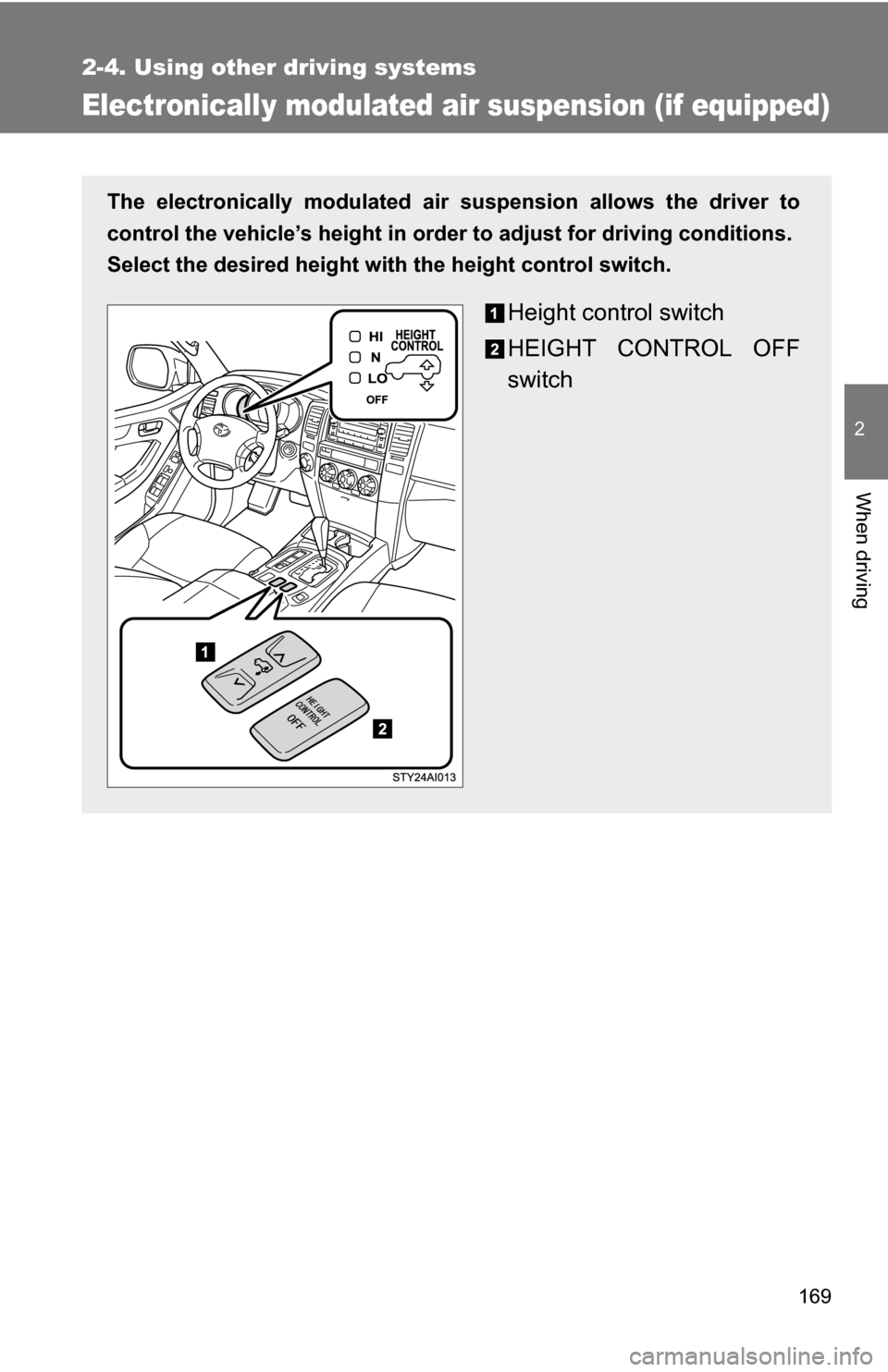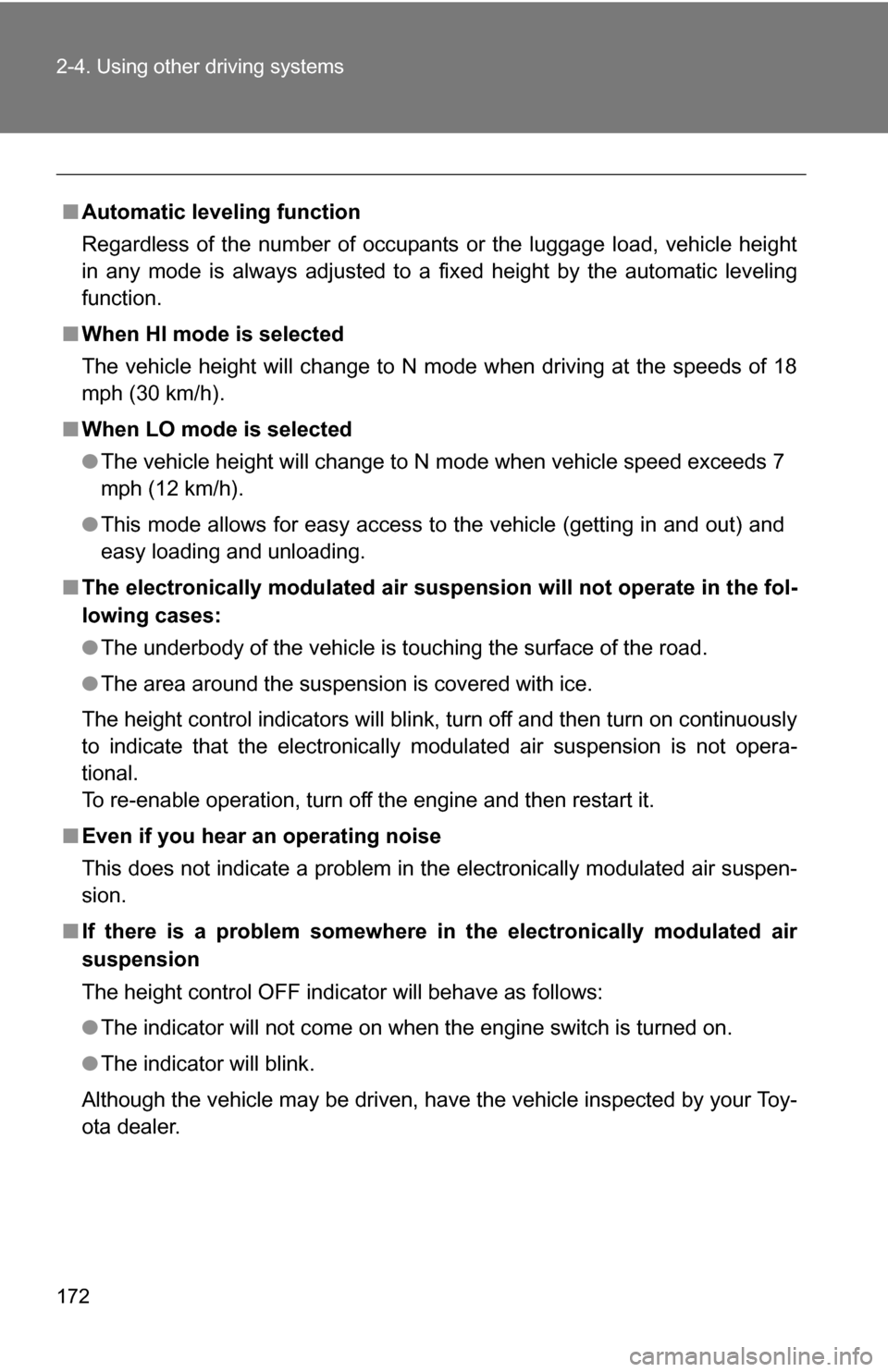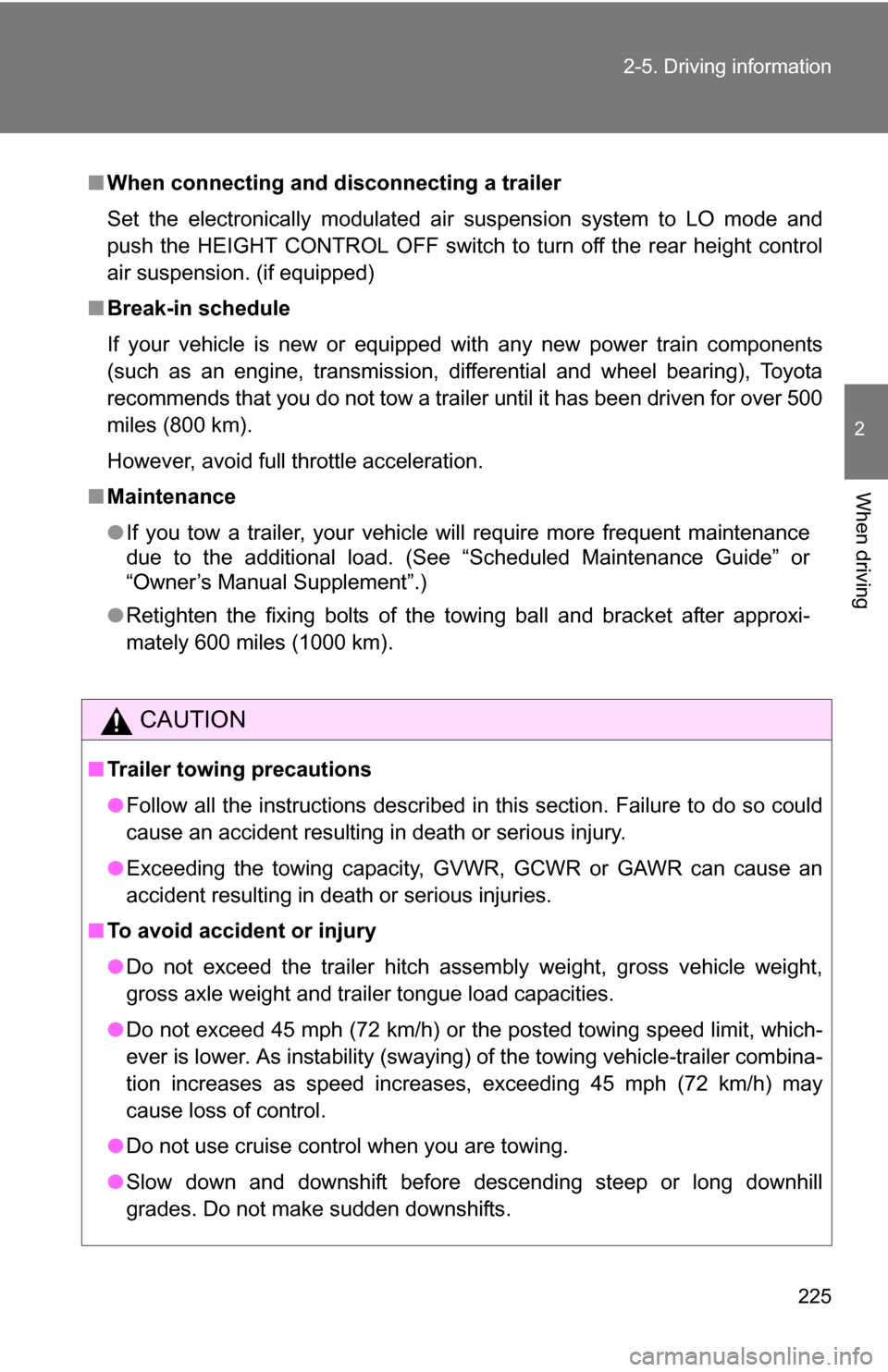2009 TOYOTA 4RUNNER air suspension
[x] Cancel search: air suspensionPage 3 of 520

1
2
3
4
5
6
7
3
Rear window wiper and washer .............................. 165
2-4. Using other driving systems Cruise control ...................... 166
Electronically modulated air suspension................... 169
AUTO LSD system (2WD models and
Multi-mode 4WD
models) ............................. 175
Four-wheel drive system (4WD models) ................... 177
Active traction control system (L4 mode on 4WD
models) ............................. 182
Rear differential lock system .............................. 184
Downhill Assist Control ....... 186
Driving assist systems ........ 188
2-5. Driving information Off-road precautions ........... 198
Cargo and luggage ............. 203
Vehicle load limits ............... 211
Winter driving tips ............... 213
Trailer towing ...................... 216
Dinghy towing ..................... 228
3-1. Using the air conditioning
system a nd defogger
Air conditioning system ....... 230
Rear window and outside rear view mirror defoggers ....... 240 3-2. Using the audio system
Audio system (without
navigation system)
............. 241
Using the radio ................... 244
Using the CD player ........... 250
Playing back MP3 and WMA discs ....................... 257
Optimal use of the audio system .............................. 266
Using the AUX adapter....... 269
Using the steering wheel audio switches.................. 271
3-3. Using the rear audio/video
system
Rear seat entertainment system .............................. 274
Using the DVD player (DVD video)...................... 280
Using the DVD player (video CD) ........................ 288
Using the DVD player (audio CD/CD text) ........... 291
Using the DVD player (MP3 discs) ...................... 292
Using the video mode......... 294
Changing the Setup Menu settings ............................. 297
3-4. Using the interior lights Interior lights list ................. 305
• Personal lights.................. 306
• Personal/interior lights...... 307
• Interior light ...................... 307
3-5. Using the storage features List of storage features ....... 309
• Glove box ......................... 310
• Coin holder ....................... 311
3Interior features
Page 106 of 520

106 1-7. Safety information
CAUTION
■Modification and disposal of SRS airbag system components
Do not dispose of your vehicle or perform any of the following modifications
without consulting your Toyota dealer.
The SRS airbags may malfunction or deploy (inflate) accidentally, causing
death or serious injury.
● Installation, removal, disassembly and repair of the SRS airbags.
● Repairs, modifications, removal or replacement of the steering wheel,
instrument panel, dashboard, seats or seat upholstery, front, side and rear
pillars or roof side rails.
● Repairs or modifications of the front fender, front bumper, or side of the
occupant compartment.
● Installation of snow plows, winches, etc. to the front grille (bull bars, kan-
garoo bar etc.).
● Modifications to the vehicle’s suspension system.
● Installation of electronic devices such as mobile two-way radios or CD
players.
● Modifications to your vehicle for a person with a physical disability.
Page 131 of 520

When driving2
131
2-1. Driving proceduresDriving the vehicle............ 132
Engine (ignition) switch .... 140
Automatic
Transmission.... 143
Turn signal lever .............. 145
Parking brake ................... 146
Horn ................................. 147
2-2. Instrument cluster Gauges and meters ......... 148
Indicators and warning lights .............................. 151
Accessory meter .............. 155
2-3. Operating the lights and wipers
Headlight switch ............... 158
Fog light switch ................ 162
Windshield wipers and washer ........................... 163
Rear window wiper and washer ........................... 165 2-4. Using other driving systems
Cruise control ................... 166
Electronically modulated air suspension ................ 169
AUTO LSD system (2WD models and
Multi-mode 4WD
models) .......................... 175
Four-wheel drive system (4WD models) ................ 177
Active traction control system (L4 mode on
4WD models) ................. 182
Rear differential lock system ........................... 184
Downhill Assist Control .... 186
Driving assist systems ..... 188
2-5. Driving information Off-road precautions ........ 198
Cargo and luggage .......... 203
Vehicle load limits ............ 211
Winter driving tips ............ 213
Trailer towing ................... 216
Dinghy towing .................. 228
Page 169 of 520

169
2-4. Using other driving systems
2
When driving
Electronically modulated air suspension (if equipped)
The electronically modulated air suspension allows the driver to
control the vehicle’s height in order to adjust for driving conditions.
Select the desired height with the height control switch.
Height control switch
HEIGHT CONTROL OFF
switch
Page 172 of 520

172 2-4. Using other driving systems
■Automatic leveling function
Regardless of the number of occupants or the luggage load, vehicle height
in any mode is always adjusted to a fixed height by the automatic leveling
function.
■ When HI mode is selected
The vehicle height will change to N mode when driving at the speeds of 1\
8
mph (30 km/h).
■ When LO mode is selected
●The vehicle height will change to N mode when vehicle speed exceeds 7
mph (12 km/h).
● This mode allows for easy access to the vehicle (getting in and out) and
easy loading and unloading.
■ The electronically modulated air susp ension will not operate in the fol-
lowing cases:
● The underbody of the vehicle is touching the surface of the road.
● The area around the suspension is covered with ice.
The height control indicators will blink, turn off and then turn on continuously
to indicate that the electronically modulated air suspension is not opera-
tional.
To re-enable operation, turn off the engine and then restart it.
■ Even if you hear an operating noise
This does not indicate a problem in the electronically modulated air suspen-
sion.
■ If there is a problem somewhere in the electronically modulated air
suspension
The height control OFF indi cator will behave as follows:
● The indicator will not come on when the engine switch is turned on.
● The indicator will blink.
Although the vehicle may be driven, have the vehicle inspected by your Toy-
ota dealer.
Page 173 of 520

173
2-4. Using other
driving systems
2
When driving
CAUTION
■The electronically modulated air susp ension must be turned off in the
following circumstances:
Otherwise, the automatic leveling function may cause the vehicle’s height to
change, resulting in an unexpected accident.
● When driving through water such as shallow streams (Put the vehicle
height in HI mode and turn off the electronically modulated air suspension.
Drive at 18 mph [30 km/h] or slower.)
● When jacking up the vehicle, installing tire chains or tying the vehicle with
chains/wires for transportation via flat bed truck (Turn the system off and
stop the engine.)
● When the vehicle must be towed (Put the vehicle height in N mode and
turn the system off.)
● When the vehicle gets stuck (Turn the system off.)
● When disconnecting a trailer (Put the vehicle height in LO mode and turn
the system off.)
■ Selecting the correct height mode
Observe the following precautions to prevent accidents.
Failure to do so may cause damage to parts of the vehicle, as well as dan-
gerous handling characteristics, which may lead to fatal or injury accidents.
●Before you lower the vehicle’s height, check under the vehicle to make
sure that no one is there.
● The HI mode should be used for off-road driving conditions.
As the vehicle’s center of gravity is higher in this setting, the vehicle may
become unstable when turning abruptly.
● Do not select HI mode when you load cargo on the roof luggage carrier.
This may result in a loss of control or vehicle rollover.
Page 225 of 520

225
2-5. Driving information
2
When driving
■
When connecting and disconnecting a trailer
Set the electronically modulated air suspension system to LO mode and
push the HEIGHT CONTROL OFF switch to turn off the rear height control
air suspension. (if equipped)
■ Break-in schedule
If your vehicle is new or equipped with any new power train components
(such as an engine, transmission, differential and wheel bearing), Toyota
recommends that you do not tow a trailer until it has been driven for over 500
miles (800 km).
However, avoid full throttle acceleration.
■ Maintenance
●If you tow a trailer, your vehicle will require more frequent maintenance
due to the additional load. (See “Scheduled Maintenance Guide” or
“Owner’s Manual Supplement”.)
● Retighten the fixing bolts of the towing ball and bracket after approxi-
mately 600 miles (1000 km).
CAUTION
■Trailer towing precautions
●Follow all the instructions described in this section. Failure to do so could
cause an accident resulting in death or serious injury.
● Exceeding the towing capacity, GVWR, GCWR or GAWR can cause an
accident resulting in death or serious injuries.
■ To avoid accident or injury
●Do not exceed the trailer hitch assembly weight, gross vehicle weight,
gross axle weight and trailer tongue load capacities.
● Do not exceed 45 mph (72 km/h) or the posted towing speed limit, which-
ever is lower. As instability (swaying) of the towing vehicle-trailer combina-
tion increases as speed increases, exceeding 45 mph (72 km/h) may
cause loss of control.
● Do not use cruise control when you are towing.
● Slow down and downshift before descending steep or long downhill
grades. Do not make sudden downshifts.
Page 357 of 520

357
4-1. Maintenance and care
4
Maintenance and care
■
Rear height control air suspension (if equipped)
Do not spray a jet of high-pressure water at the air suspension unit, espe-
cially the air spring, at an extremely close range. This may damage the air
suspension.
■ Coating of rain clearing mirrors
To maintain the rain clearing ability, observe the following instructions.
●Clean the mirror with car shampoo or glass cleaner that does not contain
any silicon or abrasive, and then rinse it throughly with water.
● Expose the mirror to the sunlight 1 or 2 days.
■ To prevent deteriorati on and body corrosion
● Wash the vehicle immediately in the following cases:
• After driving near the sea coast
• After driving on salted roads
• If you see coal tar or tree sap on the paint surface
• If you see dead insects or insect droppings on the paint
• After driving in an area contaminated with soot, oily smoke, mine dust,
iron powder or chemical substances
• If the vehicle becomes heavily soiled in dust or mud
• If liquids such as benzene and gasoline are spilled on the paint surface
● If the paint is chipped or scratched, have it repaired immediately.
CAUTION
■Caution about the exhaust pipe
Exhaust gasses cause the exhaust pipe to become quite hot.
When washing the vehicle, be careful not to touch the pipe until it has cooled
sufficiently, as touching a hot exhaust pipe can cause burns.